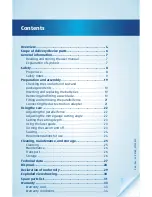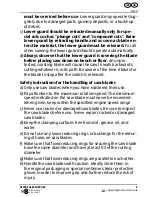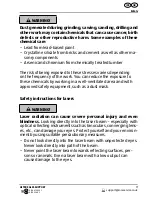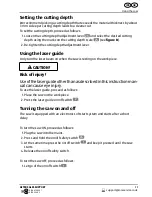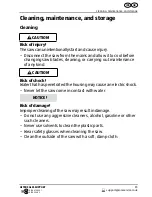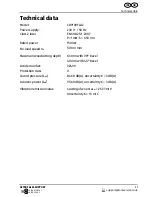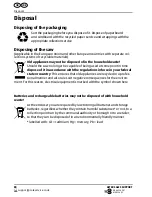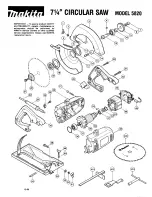
Safety
14
GB
14
IRE
AFTER SALES SUPPORT
GB
IRE
0190 226 05
0190 472 0501
less in the material until the blade comes to a complete
stop. Never attempt to remove the saw from the work
or pull the saw backward while the blade is in motion or
kickback may occur. Investigate and take corrective actions to
eliminate the cause of blade binding.
c)
When restarting a saw in the workpiece, centre the saw
blade in the kerf and check that saw teeth are not en-
gaged into the material. If saw blade is binding, it may walk
up or kickback from the workpiece as the saw is restarted.
d)
Support large panels to minimise the risk of blade pinch-
ing and kickback. Large panels tend to sag under their own
weight. Supports must be placed under the panel on both
sides, near the line of cut and near the edge of the panel.
e)
Do not use dull or damaged blades. Unsharpened or im-
properly set blades produce narrow kerf causing excessive
friction, blade binding and kickback.
f)
Blade depth and bevel adjusting locking levers must be
tight and secure before making a cut. If blade adjustment
shifts while cutting, it may cause binding and kickback.
g)
Use extra caution when making a “plunge cut” into exist-
ing walls or other blind areas. The protruding blade may cut
objects that can cause kickback.
Safety instructions for circular saws
Operation of the lower guard:
a)
Check lower guard for proper closing before each use. Do
not operate the saw if lower guard does not move freely
and close instantly. Never clamp or tie the lower guard into
the open position. If saw is accidentally dropped, lower guard
may be bent. Raise the lower guard with the retracting handle
and make sure it moves freely and does not touch the blade or
any other part, in all angles and depths of cut.
b)
Check the operation of the lower guard spring. If the
guard and the spring are not operating properly, they



